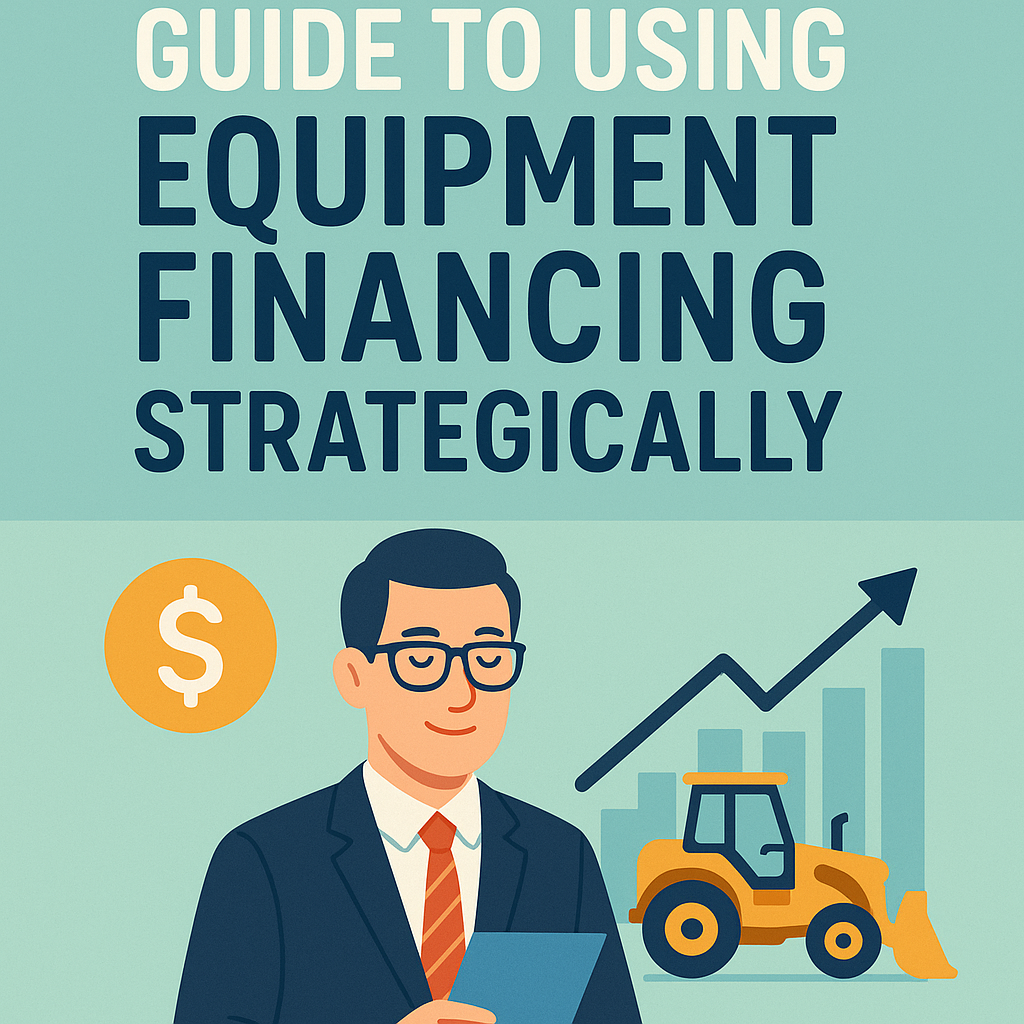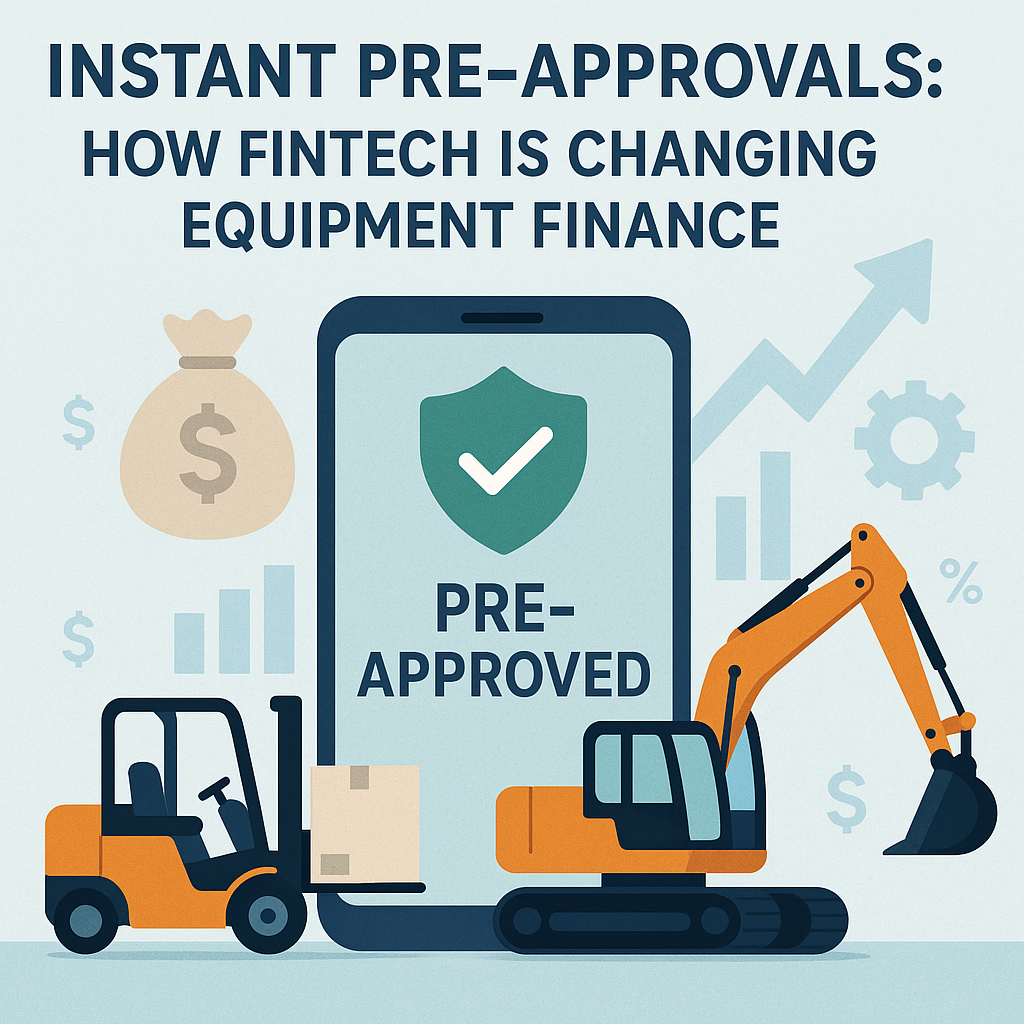Equipment Financing: Complete Guide to Business Equipment Loans and Startup Financing Solutions

Equipment financing represents a critical financial strategy that enables businesses to acquire essential machinery, technology, and operational assets without exhausting their capital reserves. This comprehensive guide covers everything from traditional equipment loans for startups to modern easy equipment financing solutions available through digital platforms.
With the rise of specialized equipment financing platforms and innovative lending solutions, businesses of all sizes can now access the tools they need to grow and compete effectively in today’s market.
Table of Contents
- Understanding Equipment Financing Fundamentals
- Strategic Advantages of Equipment Financing
- Potential Disadvantages and Risk Factors
- Startup Equipment Financing Solutions
- Industry-Specific Equipment Financing
- Choosing the Best Equipment Financing Companies
- Equipment Financing Terms and Structures
- Strategic Decision Making for Equipment Purchases
- Frequently Asked Questions
Understanding Equipment Financing Fundamentals
Equipment financing involves borrowing money specifically to purchase business equipment, with the acquired asset serving as loan collateral. Unlike traditional business loans, this financing type is secured by the equipment itself, creating unique advantages and considerations for business owners.
Modern equipment financing solutions, including specialized startup equipment loans and new business equipment financing programs, have made these opportunities more accessible than ever before. The digital transformation of lending has created numerous easy equipment financing options that streamline the application and approval process.
Types of Equipment Financing Structures
Direct Equipment Loans: Businesses receive funds to purchase equipment and own the asset immediately, building equity while making payments.
Equipment Leasing: Functions like renting equipment with options to purchase at term end, offering lower monthly payments and easier upgrades.
Capital Leases: Transfer ownership to the lessee at completion, combining benefits of ownership with manageable payment structures.
Operating Leases: Provide equipment use without ownership obligations, ideal for rapidly evolving technology or seasonal equipment needs.
The best equipment financing companies now provide multiple structure options within single applications, allowing businesses to choose the most suitable arrangement for their specific needs and financial situations.
Strategic Advantages of Equipment Financing
Capital Conservation Strategy
Equipment financing serves as a powerful capital preservation tool, allowing businesses to maintain cash reserves for unexpected opportunities, operational challenges, or strategic investments. This approach prevents the depletion of working capital that could otherwise support growth initiatives or provide financial cushioning during market fluctuations.
Enhanced Financial Leverage
By utilizing equipment financing, businesses can amplify their purchasing power and acquire assets that generate revenue streams exceeding the financing costs. This leverage effect enables companies to grow faster than organic cash flow would typically permit, creating competitive advantages in rapidly evolving markets.
Accelerated Technology Adoption
In industries where technological advancement moves quickly, equipment financing enables businesses to stay current with cutting-edge tools and machinery. Companies can upgrade systems regularly without massive capital outlays, maintaining operational efficiency and market competitiveness through easy equipment financing solutions.
Tax Optimization Benefits
Equipment financing often provides significant tax advantages through Section 179 deductions, bonus depreciation, and interest payment deductibility. These benefits can substantially reduce the effective cost of equipment acquisition while improving cash flow through tax savings.
Improved Financial Ratios
Certain equipment financing structures can improve balance sheet metrics by keeping debt off books or categorizing payments as operational expenses rather than debt service. This improvement can enhance creditworthiness for future financing needs and present stronger financial positions to stakeholders.
Flexible Payment Structures
Many equipment financing agreements offer payment structures aligned with business cycles. Agricultural businesses can arrange payments coinciding with harvest seasons, while retail operations might structure payments around peak sales periods, creating customized solutions that match cash flow patterns.
Potential Disadvantages and Risk Factors
Long-term Financial Commitment
Equipment financing creates extended financial obligations that persist regardless of business performance or equipment utility. These commitments can strain cash flow during difficult periods and limit financial flexibility for other opportunities or emergencies.
Total Cost of Ownership
The most significant consideration in equipment financing is the total cost including interest, fees, insurance, and maintenance requirements. Over the financing term, businesses typically pay 20-40% more than the equipment’s purchase price, making cost-benefit analysis crucial.
Accelerated Obsolescence Risk
In rapidly changing industries, financed equipment may become outdated before loan completion, leaving businesses paying for assets that no longer provide competitive advantages. This risk is particularly acute in technology-dependent sectors where innovation cycles are short.
Collateral and Default Consequences
Since equipment serves as collateral in most equipment financing arrangements, defaulting on payments can result in asset repossession. Equipment loss can severely disrupt business operations, particularly when the financed asset is central to production or service delivery.
Hidden Cost Accumulation
Beyond interest charges, equipment financing often includes origination fees, documentation costs, insurance requirements, and maintenance obligations. These additional expenses can significantly increase the total cost of acquisition beyond initial calculations.
Startup Equipment Financing Solutions
Equipment financing for startups presents unique challenges and opportunities for entrepreneurs. The landscape has evolved significantly, with many lenders now offering specialized startup equipment loan programs designed to support emerging businesses.
Specialized Startup Programs
New business equipment financing programs recognize that startups often lack extensive credit histories but possess strong business potential and valuable equipment collateral. These programs feature more flexible underwriting criteria, considering factors like:
- Business plans and financial projections
- Industry experience and management expertise
- Equipment value and marketability
- Personal credit scores and guarantees
- Cash flow potential and market opportunity
Digital Platform Solutions
Many equipment financing platforms have launched dedicated startup divisions, offering streamlined applications and faster approval processes specifically tailored for new businesses. These platforms provide:
- Easy equipment financing applications with minimal documentation
- Instant pre-qualification tools
- Multiple lender comparisons
- Educational resources and guidance
- Accelerated approval timelines
Startup-Friendly Features
Equipment loans for startups often include features designed to support growing businesses:
- Lower down payment requirements
- Flexible payment schedules during ramp-up periods
- Equipment upgrade options
- Business mentorship programs
- Expedited processing for time-sensitive opportunities
Success Strategies for Startup Equipment Financing
To maximize approval chances and secure favorable terms, startups should:
- Prepare comprehensive business plans with realistic financial projections
- Document industry experience and relevant expertise
- Maintain strong personal credit scores
- Research equipment values and obtain multiple quotes
- Consider co-signers or additional collateral when necessary
- Work with lenders experienced in new business equipment financing
Industry-Specific Equipment Financing
Different industries experience unique equipment financing dynamics, with specialized lenders and programs designed to address sector-specific needs and challenges.
Manufacturing Equipment Financing
Manufacturing businesses often finance heavy machinery with long useful lives, making traditional equipment loans attractive. Key considerations include:
- Extended financing terms matching equipment lifespan
- Seasonal payment options for cyclical production
- Flexibility for equipment modifications and upgrades
- Integration with working capital financing for comprehensive solutions
Technology Equipment Financing
Technology companies frequently prefer leasing arrangements that facilitate regular upgrades and equipment refresh cycles. Easy equipment financing platforms often specialize in technology sectors, offering:
- Short-term financing matching technology lifecycles
- Upgrade and refresh programs
- End-of-term buyout options
- Rapid approval processes for time-sensitive purchases
Healthcare Equipment Financing
Healthcare providers require specialized equipment financing that accommodates regulatory requirements and equipment certification needs. Features include:
- Compliance with healthcare regulations
- Extended warranties and service agreements
- Integration with practice management systems
- Flexible terms for expensive diagnostic equipment
Construction Equipment Financing
Construction companies utilize equipment financing with payment structures aligned with project completion cycles and seasonal business patterns:
- Seasonal payment deferrals during slow periods
- Job-specific equipment financing
- Fleet financing for multiple equipment pieces
- Rapid deployment for project-specific needs
The best equipment financing companies often specialize in specific industries, providing tailored solutions that address sector-specific challenges and opportunities while offering competitive rates and expert guidance.
Choosing the Best Equipment Financing Companies
The modern equipment financing landscape features numerous platforms and lenders, each offering distinct advantages. Selecting the right provider requires careful evaluation of multiple factors beyond interest rates.
Digital Platform Advantages
Easy equipment financing platforms have revolutionized the application and approval process, offering:
- Online applications with instant pre-approvals
- Digital document submission and processing
- Transparent pricing and term comparisons
- Multiple lender network access
- Real-time application status tracking
Evaluation Criteria for Equipment Financing Companies
Interest Rates and Fees: Compare total cost of financing including origination fees, processing charges, and prepayment penalties across multiple providers.
Approval Speed and Process: Consider application complexity, documentation requirements, and typical approval timelines, especially for time-sensitive equipment purchases.
Industry Expertise: Choose lenders with experience in your specific industry, understanding unique equipment types, usage patterns, and market dynamics.
Flexibility and Customization: Evaluate payment structure options, term lengths, and ability to accommodate unique business needs or seasonal patterns.
Customer Service Quality: Assess responsiveness, expertise level, and ongoing support availability throughout the financing relationship.
Technology Integration: Consider platforms offering digital tools, online account management, and integration with business systems.
Top Features of Leading Equipment Financing Companies
The best equipment financing companies typically offer:
- Multiple financing structure options within single applications
- Competitive rates across various credit profiles
- Streamlined application and approval processes
- Industry-specific expertise and specialized programs
- Comprehensive customer support and guidance
- Flexible payment and term options
- Digital account management tools
- Educational resources and business support services
Equipment Financing Platform Selection Tips
When choosing an equipment financing platform, consider:
- Lender Network Size: Platforms with larger networks provide more options and competitive rates
- Technology Capabilities: User-friendly interfaces and mobile accessibility improve experience
- Transparency: Clear pricing, terms, and fee disclosure throughout the process
- Speed: Fast pre-qualification and approval processes for urgent equipment needs
- Support: Available assistance throughout application and financing processes
Equipment Financing Terms and Structures
Understanding equipment financing terms and structures is crucial for making informed decisions that align with business objectives and cash flow capabilities.
Financing Term Lengths
Equipment financing terms typically range from 12 months to 7 years, with length often determined by:
- Equipment expected useful life and depreciation schedule
- Loan amount and monthly payment capacity
- Industry standards and equipment type
- Borrower creditworthiness and down payment amount
Interest Rate Factors
Equipment financing interest rates vary based on multiple factors:
- Credit Profile: Business and personal credit scores significantly impact rates
- Down Payment: Higher down payments often secure better interest rates
- Equipment Type: Some equipment types are considered lower risk, resulting in better rates
- Term Length: Shorter terms typically offer lower rates but higher monthly payments
- Market Conditions: Economic factors and lender competition influence rate availability
Down Payment Requirements
Equipment financing down payment requirements vary by lender and situation:
- Zero Down Programs: Available for strong credit profiles or specific equipment types
- Standard Requirements: Typically 10-30% of equipment cost
- High-Risk Situations: May require 30-50% down payment for newer businesses or specialized equipment
Payment Structure Options
Fixed Rate Payments: Predictable monthly payments throughout the financing term, simplifying budgeting and cash flow planning.
Variable Rate Payments: Payments that fluctuate with market conditions, potentially offering lower initial rates with interest rate risk.
Seasonal Payments: Customized payment schedules aligned with business cash flow patterns, common in agricultural and retail sectors.
Balloon Payments: Lower regular payments with larger final payment, suitable for businesses expecting future cash flow improvements.
Skip Payment Options: Predetermined periods where payments can be deferred, providing flexibility during challenging periods.
Strategic Decision Making for Equipment Purchases
Successful equipment financing requires comprehensive analysis beyond simple cost comparisons, incorporating strategic business objectives and long-term financial implications.
Return on Investment Analysis
Before pursuing equipment financing, businesses should calculate potential returns through:
- Revenue Generation: Direct income increases from new equipment capabilities
- Cost Reduction: Labor savings, efficiency improvements, and reduced operational expenses
- Productivity Gains: Increased output capacity and improved quality standards
- Competitive Advantages: Market positioning improvements and customer service enhancements
Total Cost of Ownership Evaluation
Equipment financing decisions should consider comprehensive ownership costs:
- Financing Costs: Interest, fees, and total payment amounts over financing terms
- Operating Expenses: Maintenance, repairs, insurance, and utility costs
- Training and Implementation: Staff training, installation, and integration expenses
- Opportunity Costs: Alternative uses for capital and potential investment returns
Timing Considerations
Strategic timing can significantly impact equipment financing success:
- Market Conditions: Interest rate environments and equipment pricing cycles
- Business Cycles: Seasonal patterns and anticipated cash flow variations
- Tax Planning: Timing purchases to maximize tax benefits and deductions
- Competitive Factors: Market pressures and competitive equipment requirements
Cash Flow Impact Assessment
Equipment financing should align with business cash flow capabilities:
- Payment Affordability: Ensuring payments don’t strain operational cash flow
- Growth Projections: Matching payment schedules with anticipated business growth
- Emergency Reserves: Maintaining adequate cash reserves for unexpected challenges
- Alternative Financing: Evaluating other financing options and their cash flow implications
Frequently Asked Questions About Equipment Financing
General Equipment Financing Questions
Q: What credit score is needed for equipment financing? A: Most equipment financing providers require minimum credit scores of 650-680 for competitive rates, though specialized lenders work with scores as low as 500-550. Startup equipment loans may have more flexible credit requirements since equipment serves as collateral. Personal credit scores, business credit history, and financial statements all influence approval decisions and terms.
Q: How quickly can equipment financing be approved? A: Easy equipment financing platforms often provide approvals within 24-48 hours for straightforward applications. Traditional lenders may require 1-2 weeks for complex transactions. Equipment financing platforms with streamlined processes typically offer the fastest approval times, especially for standard equipment types and qualified borrowers.
Q: What documentation is required for equipment financing applications? A: Standard equipment financing applications require business financial statements, tax returns, bank statements, equipment quotes, and business licenses. New business equipment financing may require additional documentation like business plans, personal financial statements, and owner guarantees. Complete documentation packages accelerate approval processes significantly.
Q: Can multiple pieces of equipment be financed together? A: Yes, equipment financing packages allow multiple assets under single agreements, often providing better rates and simplified payment structures. The best equipment financing companies offer flexible packaging options that can include related equipment, installation costs, and even training expenses in comprehensive financing solutions.
Startup Equipment Financing Questions
Q: Can startups qualify for equipment financing? A: Equipment financing for startups is widely available, with many lenders offering specialized startup equipment loan programs. While startups may face higher rates or down payment requirements, the equipment collateral makes approval more accessible than unsecured business loans. New business equipment financing programs consider business plans, industry experience, and equipment value alongside traditional credit metrics.
Q: What are the best equipment financing options for new businesses? A: New business equipment financing options include SBA-backed loans, specialized startup lenders, and equipment financing platforms with new business divisions. The best equipment financing companies for startups offer flexible underwriting, competitive rates, and business support services designed specifically for emerging businesses.
Q: How can startups improve their equipment financing approval chances? A: Startups can improve startup equipment loan approval odds by maintaining strong personal credit, preparing comprehensive business plans, demonstrating industry experience, and considering larger down payments. Working with lenders experienced in equipment financing for startups also increases success probability.
Technical Equipment Financing Questions
Q: What happens if financed equipment breaks down? A: Borrowers remain responsible for equipment financing payments regardless of equipment condition. Many lenders require comprehensive insurance coverage and maintenance agreements to protect against breakdown risks. Some equipment financing packages include extended warranties or service contracts for additional protection.
Q: Can equipment be refinanced if rates drop? A: Equipment financing refinancing is possible but less common than real estate refinancing. Success depends on current equipment value, remaining loan balance, and creditworthiness. Prepayment penalties may apply, so calculate total refinancing costs carefully before proceeding with new equipment financing arrangements.
Q: Are there tax advantages to equipment financing vs. purchasing? A: Both equipment financing and cash purchases offer tax benefits with different implications. Financed equipment may qualify for Section 179 deductions and bonus depreciation, while financing interest is typically deductible. Equipment financing structures like leases may allow full payment deductibility as business expenses. Consult tax professionals for situation-specific guidance.
Industry and Platform Questions
Q: Which industries have the best equipment financing options? A: Industries with equipment that retains value typically receive favorable equipment financing terms. Manufacturing, construction, transportation, and healthcare often access competitive rates due to equipment liquidity and proven business models. The best equipment financing companies often specialize in specific industries, providing tailored solutions and competitive terms.
Q: How do equipment financing platforms compare to traditional lenders? A: Equipment financing platforms typically offer faster approvals, transparent pricing, and streamlined applications compared to traditional lenders. However, traditional lenders may provide more personalized service and flexible terms for complex transactions. Easy equipment financing platforms excel in standard transactions, while traditional lenders may be better for unique or high-value equipment purchases.
Q: What should businesses look for in equipment financing companies? A: When evaluating equipment financing providers, consider interest rates, approval speed, industry expertise, customer service quality, and financing flexibility. The best equipment financing companies combine competitive pricing with excellent service, offering guidance throughout the process and ongoing support after loan origination.
Advanced Equipment Financing Questions
Q: How does equipment leasing differ from equipment financing? A: Equipment financing typically leads to ownership, while leasing functions like renting with potential purchase options. Financing builds asset equity, while leasing offers lower payments and easier upgrades. Tax implications, balance sheet treatment, and end-of-term options vary significantly between approaches.
Q: Can equipment financing improve business credit scores? A: Timely equipment financing payments can improve business credit scores and establish positive credit history. These loans demonstrate secured debt management capability, potentially qualifying businesses for future financing at better terms through improved credit profiles.
Q: What happens at the end of equipment financing terms? A: Traditional equipment financing transfers full ownership once final payments are made. Some agreements include balloon payments or purchase options that require additional consideration. Understanding end-of-term obligations and ownership transfer processes is crucial before signing equipment financing agreements.
Q: How can businesses negotiate better equipment financing terms? A: Businesses can improve equipment financing terms by shopping multiple lenders, increasing down payments, demonstrating strong credit profiles, and leveraging competitive offers. Working with equipment financing platforms that provide multiple lender options often results in better terms through increased competition.
Conclusion
Equipment financing represents a powerful tool for business growth and operational enhancement, offering pathways to acquire essential assets while preserving capital and managing cash flow. From traditional equipment loans to innovative startup equipment financing solutions, modern lending platforms provide unprecedented access to equipment funding across all business stages and industries.
The evolution of easy equipment financing through digital platforms has democratized access to business equipment, enabling startups and established companies alike to compete effectively in rapidly changing markets. Success in equipment financing requires understanding available options, evaluating total costs and benefits, and selecting providers that align with specific business needs and objectives.
Whether seeking new business equipment financing or expanding existing operations, businesses benefit from comprehensive research, strategic planning, and partnerships with reputable equipment financing companies that provide transparent terms, competitive rates, and ongoing support throughout the financing relationship.




No comment